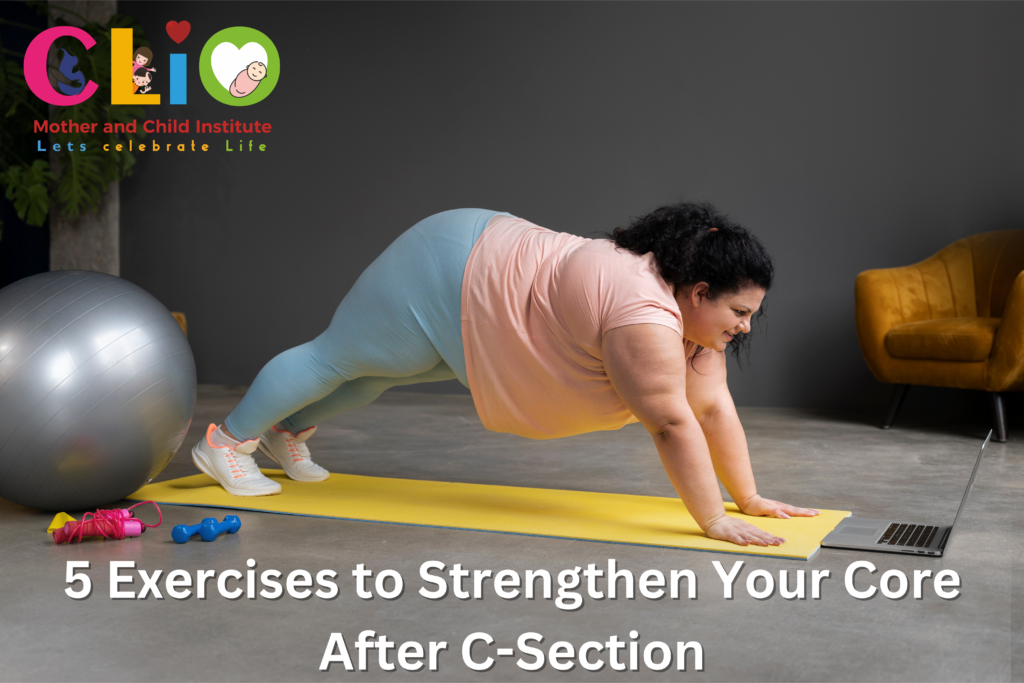Introduction:
Recovering from a C-section is a unique journey, both physically and emotionally. While the joy of welcoming a new life into the world is unparalleled, the process of healing and rebuilding strength after a Cesarean delivery can be challenging. One aspect that often requires attention is rebuilding core strength. After undergoing abdominal surgery, it’s essential to approach postpartum exercises with care and consideration. In this blog post, we’ll explore five effective exercises tailored to help strengthen your core after a C-section, promoting healing and restoring vitality.
- Pelvic Tilts:
Pelvic tilts are gentle yet effective exercises that engage your abdominal muscles without putting excessive strain on your healing incision. To perform pelvic tilts, lie on your back with your knees bent and feet flat on the floor. Inhale deeply, and as you exhale, tilt your pelvis upward, pressing your lower back into the floor. Hold this position for a few seconds, then release as you inhale. Repeat this movement for 10-15 repetitions, gradually increasing as your strength improves.
Pelvic tilts help activate and strengthen the deep abdominal muscles, promoting better pelvic alignment and stability. Additionally, they can alleviate lower back pain and improve overall posture, which is especially beneficial during the postpartum period when your body adjusts to new demands.
- Modified Planks:
Planks are renowned for their ability to target the core muscles effectively. However, traditional planks may not be suitable for women recovering from a C-section due to the strain they place on the abdominal area. Modified planks offer a safer alternative while still providing significant benefits.
To perform a modified plank, start on your hands and knees, ensuring your wrists are aligned with your shoulders and your knees are beneath your hips. Engage your core muscles and extend one leg back, followed by the other, until your body forms a straight line from head to heels. Hold this position for 10-20 seconds, focusing on maintaining proper alignment and breathing steadily. As you get stronger and more self-assured, gradually extend the duration.
Modified planks help strengthen the core muscles, including the transverse abdomins, without putting undue pressure on the abdominal wall. They also engage the stabilizing muscles around the shoulders, hips, and spine, promoting overall strength and stability.
- Seated Leg Lifts: Seated leg lifts are gentle yet effective exercises that target the lower abdominal muscles, which may weaken during pregnancy and childbirth. This exercise can be performed anywhere, making it convenient for busy moms to incorporate it into their daily routines.
With your feet flat on the floor and your back straight, sit on the edge of a solid chair to execute seated leg raises. For support, rest your hands on the chair’s sides. One leg should be slowly raised off the ground and extended forward until it is parallel to the floor. After a few seconds of holding this posture, carefully drop your leg back down. After ten to fifteen reps on each side, switch up your legs and repeat on the other.
Seated leg lifts help strengthen the deep abdominal muscles while also engaging the hip flexors and quadriceps. By targeting the lower abdominal area, this exercise can help improve stability and support for everyday movements, such as lifting and carrying your baby.
- Bridge Pose:
The bridge pose is a yoga-inspired exercise that targets the core, glutes, and hamstrings, making it an excellent choice for post-C-section recovery. This pose gently engages the abdominal muscles while also promoting flexibility and mobility in the spine and hips.
Lay on your back with your feet hip-width apart and your knees bent to execute the bridge posture. Put your arms down by your sides with your palms facing down. Lift your hips so that your shoulders and knees are in a straight line. Press your feet into the floor. Hold this posture for ten to twenty seconds while contracting your abdominal muscles and taking deep breaths. Return your hips to the ground slowly and deliberately.
The bridge pose helps strengthen the entire core while also stretching and releasing tension in the hip flexors and lower back. Additionally, it can improve circulation and promote relaxation, making it an ideal exercise for postpartum recovery.
- Kegel Exercises:
While not traditionally considered core exercises, Kegel exercises are essential for strengthening the pelvic floor muscles, which play a crucial role in postpartum recovery, especially after a C-section. These exercises can help improve bladder control, promote healing, and enhance overall pelvic health.
To perform Kegel exercises, sit or lie comfortably and squeeze the muscles around your vagina and anus as if you are trying to stop the flow of urine. Hold this contraction for 5-10 seconds, then relax for the same duration. Aim to complete 10-15 repetitions, gradually increasing the duration and intensity as you progress.
Kegel exercises can be done discreetly at any time, making them an excellent addition to your postpartum routine. By strengthening the pelvic floor muscles, you can improve core stability, prevent pelvic organ prolapse, and enhance sexual function and sensation.
Conclusion:
Rebuilding core strength after a C-section is a gradual process that requires patience, persistence, and proper guidance. Incorporating these five exercises into your postpartum routine can safely and effectively strengthen your core muscles, promote healing, and restore vitality. Remember to listen to your body, start slowly, and consult with your healthcare provider before beginning any new exercise program, especially during the delicate postpartum period. With dedication and care, you can embark on a journey toward a stronger, healthier, and more vibrant post-C-section recovery.


